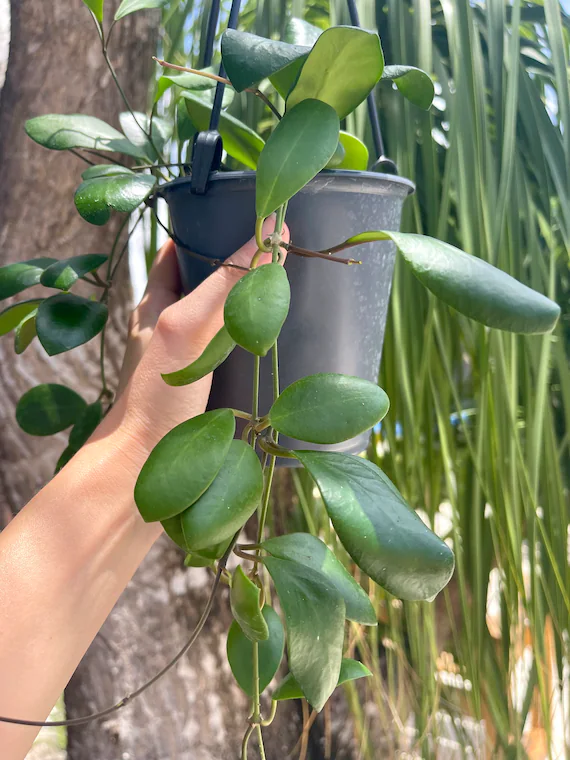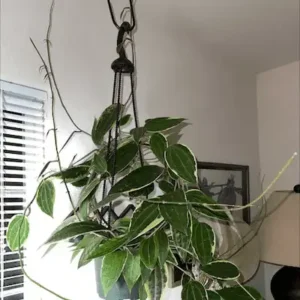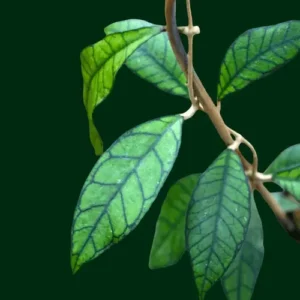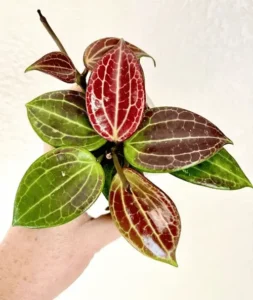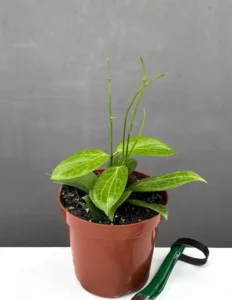Introduction
Purchasing Hoya plants from Home Depot is a great step to adding greenery to your home. Hoyas have gained immense popularity as houseplants, especially for indoor gardening enthusiasts. The Hoya plant, commonly known as the “wax plant,” is an evergreen perennial famous for its thick, waxy leaves and star-shaped, fragrant flowers. One of the reasons for their popularity is their ability to thrive in various indoor environments while requiring minimal care compared to other houseplants. As people increasingly search for low-maintenance and aesthetic indoor plants, Hoyas stand out. Whether you’re a novice or an experienced plant lover.
A Comprehensive Guide to Growing and Caring for Hoya from Home Depot
Overview of Hoya Plant
Hoyas are vining plants that belong to the Apocynaceae family, which includes over 200 different species. Their waxy, semi-succulent leaves store moisture, making them drought-tolerant and suitable for indoor spaces where consistent care may not always be possible. In terms of appearance, Hoya plants range from lush green to variegated varieties with cream, pink, and even purple hues. The plant’s flowers bloom in clusters and are often fragrant, attracting plant lovers for their beauty and aroma.
Among the popular Hoya species, Hoya carnosa, Hoya kerrii (also known as the “Sweetheart Plant” due to its heart-shaped leaves), and Hoya pubicalyx are commonly available at garden centers like Home Depot.
Why Choose Home Depot for Your Hoya Plant?
Home Depot is a convenient and trusted source for purchasing Hoya plants. With a broad range of indoor plant selections, including the Hoya, Home Depot offers high-quality plants at competitive prices. They are known for their variety, customer service, and plant-care resources, providing both in-store and online shopping options.
Here are a few reasons why Home Depot might be your go-to place for buying a Hoya plant:
-Wide Selection
Home Depot often carries multiple varieties of Hoyas, giving you the option to choose the one that best suits your space and preferences.
-Competitive Pricing
Compared to local plant nurseries or boutique garden shops, Home Depot offers Hoya plants at reasonable prices, making it affordable for new plant owners.
-Accessibility
With multiple locations nationwide and a comprehensive online store, Home Depot makes it easy for you to pick up or order a Hoya plant with delivery options.
-Plant Care Resources
Home Depot often provides additional care instructions and tips for customers, ensuring that you have the information needed to help your Hoya thrive.
Types of Hoya Plants Available at Home Depot
1. Hoya Carnosa
Hoya carnosa is the most widely recognized and cultivated variety. Known for its thick, green leaves that develop clusters of star-shaped flowers, this plant is perfect for beginners due to its adaptability and low-maintenance nature. It can thrive in indirect light and requires minimal watering, making it suitable for busy homeowners.
- Appearance: Glossy, green leaves with pale or pink flower clusters.
- Care: This variety prefers bright, indirect sunlight and needs well-draining soil. Water when the soil is dry to the touch.
2. Hoya Kerrii (Sweetheart Plant)
Often sold as single-leaf cuttings in heart-shaped form, Hoya kerrii is an adorable and trendy plant. The heart-shaped leaves are what give it its nickname, the Sweetheart Plant. This Hoya is a popular gift for special occasions like Valentine’s Day.
- Appearance: Thick, heart-shaped leaves that are dark green, sometimes variegated.
- Care: Prefers bright light and well-drained soil. Water moderately but avoid letting the soil stay wet for long periods.
3. Hoya Pubicalyx
Another attractive variety, Hoya pubicalyx boasts dark green leaves and clusters of reddish or pink flowers. This variety tends to grow faster than other Hoyas and is less finicky about light conditions, making it an excellent choice for intermediate plant parents.
- Appearance: Dark green leaves with speckled silver, and clusters of pink or red flowers.
- Care: Thrives in bright, indirect light but can tolerate lower light conditions. Ensure soil drains well to avoid root rot.
4. Hoya Obovata
Known for its large, round leaves, Hoya obovata is another beautiful Hoya variety available at Home Depot. The thick, succulent leaves help the plant retain water, which makes it a low-maintenance choice.
- Appearance: Round, thick, green leaves with a slight sheen.
- Care: This Hoya enjoys bright, indirect light and moderate watering. Like other Hoyas, it thrives in well-draining soil.
How to Care for Your Hoya Plant
While Hoyas are relatively low-maintenance, they do have some specific care needs to ensure they grow well and bloom regularly. Below are key aspects of Hoya care:
1. Light Requirements
Hoyas prefer bright, indirect light but can tolerate lower light conditions. A north or east-facing window is ideal. However, if your Hoya doesn’t get enough light, it might not bloom. Avoid direct sunlight, as it can scorch the leaves, especially for more sensitive varieties like Hoya carnosa.
For indoor growers using artificial lights, full-spectrum grow lights can supplement light requirements and promote flowering.
2. Watering
One of the great things about Hoya plants is that they don’t need frequent watering. Hoyas are semi-succulents, meaning they can store water in their thick leaves. Wait until the top 1-2 inches of soil are dry before watering again. Overwatering can lead to root rot, a common issue in houseplants, so it’s essential to have well-draining soil and avoid waterlogged pots.
In the winter months, when the plant’s growth slows, reduce watering frequency to prevent overwatering.
3. Humidity and Temperature
Hoyas thrive in moderate humidity, similar to their native tropical environments. While they can tolerate standard indoor humidity levels, increasing humidity using a humidifier or a pebble tray can promote healthier growth and flowering.
In terms of temperature, Hoyas prefer a warm environment between 60-80°F. They should not be exposed to temperatures below 50°F for extended periods, as cold drafts can cause damage to the plant.
4. Soil and Potting
Hoyas need well-draining soil to avoid water retention and root rot. A standard indoor potting mix with added perlite or orchid bark works well for these plants. Some garden centers, including Home Depot, offer specialized Hoya or succulent soil that ensures proper drainage and aeration.
Hoyas prefer to be slightly root-bound, so they don’t require frequent repotting. However, if the plant outgrows its pot or roots start poking out of the drainage holes, repotting may be necessary. Spring is the best time to repot a Hoya plant.
5. Fertilization
Feeding your Hoya plant with a balanced liquid fertilizer every 4-6 weeks during the growing season (spring and summer) can encourage growth and flowering. In winter, you can reduce or stop fertilizing, as the plant will enter a semi-dormant phase.
6. Pruning and Support
Hoyas are natural climbers and will benefit from trellises or other supports to help them grow upward. Pruning the plant can also help shape it and encourage more bushy growth. Trim away any dead or damaged leaves regularly, but avoid cutting back too much, especially the stems with flower buds, as these are the points from which Hoyas bloom.
Common Issues with Hoya Plants
While Hoyas are resilient plants, they can still face a few issues. Here’s how to troubleshoot common problems:
- Yellow Leaves: This often indicates overwatering or poor drainage. Check the soil and pot to ensure it’s not too waterlogged.
- No Flowers: Hoyas can take a few years to mature and bloom. However, if your Hoya is not flowering, it might need more light. Try relocating it to a brighter spot or supplementing it with artificial light.
- Pests: Like most houseplants, Hoyas can attract pests such as spider mites, mealybugs, or aphids. Regularly check the leaves for any signs of infestation and treat them with insecticidal soap or neem oil if necessary.
| FAQs Why is Hoya so expensive? Hoyas are expensive because of their limited availability and high demand within the plants’ community. Their price range depends on the variety to which variety certain hoya belongs. Is the Hoya plant good for home? Hoya plant is a low-maintenance and easy to care for. It is the best choice if you are looking for the best indoor gardening houseplants. Where is the best place to plant a Hoya? Place a hoya plant where bright, indirect sunlight comes instead of placing it where direct sunlight comes. In case of direct sunlight, its leaves will scorch. |
Conclusion
The Hoya plant is a wonderful addition to any indoor space due to its unique, waxy leaves and stunning star-shaped flowers. Available in various species like Hoya carnosa, Hoya kerrii, and Hoya pubicalyx, Hoyas offer a range of aesthetics, making them ideal for diverse interior styles. Purchasing a Hoya plant from Home Depot provides accessibility, affordability, and quality, ensuring you get a healthy plant to begin your indoor gardening journey.
With the right care—adequate light, moderate watering, and proper humidity—your Hoya plant will not only thrive but may also reward you with its strikingly beautiful flowers. Whether you’re new to houseplants or looking to expand your collection, a Hoya plant from Home Depot is an excellent choice.

